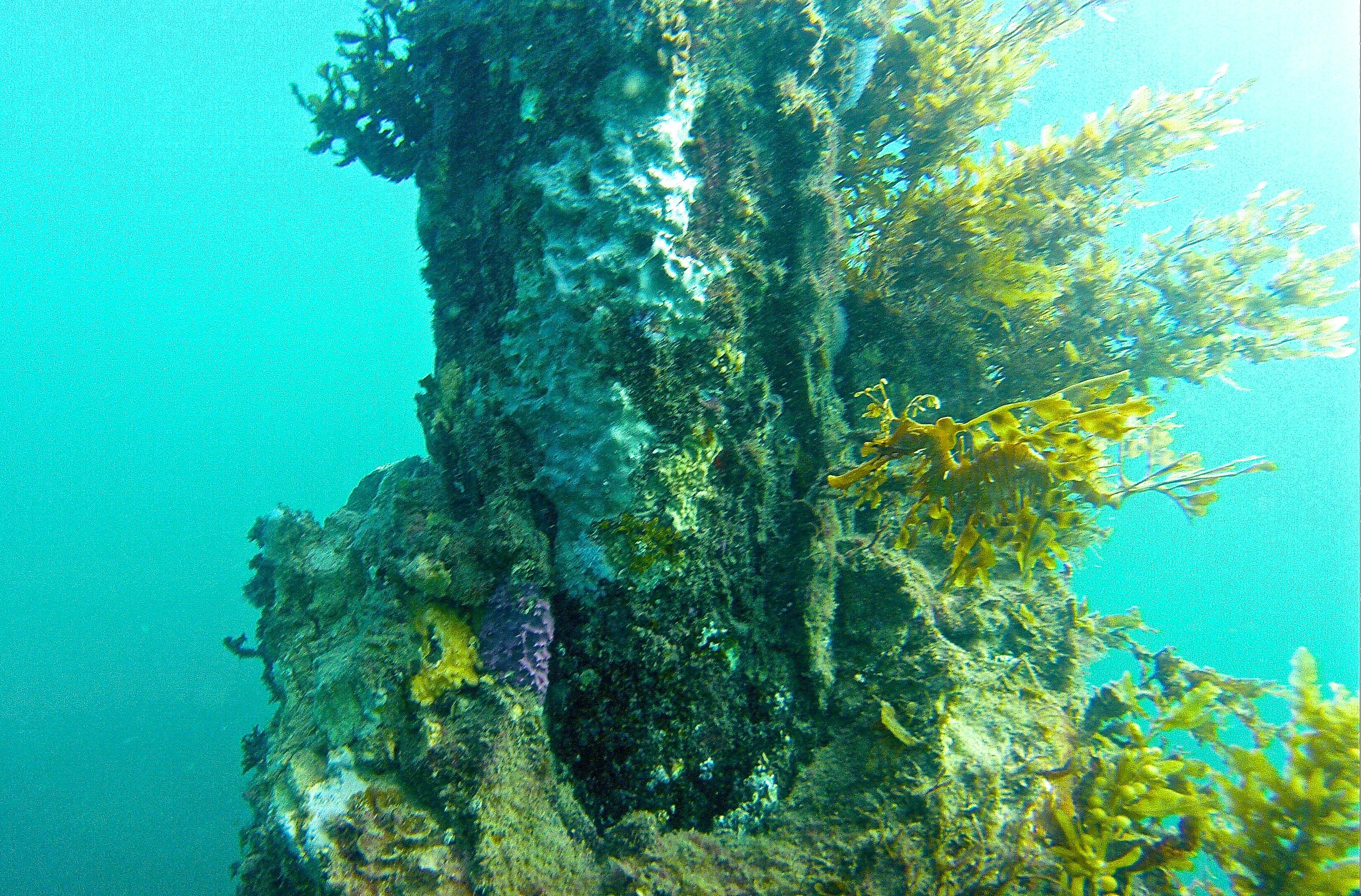THE LEAFY SEADRAGON
Year of the Leafy Seadragon
3 September 2014
My recent move to Australia coincided with the end of summer, and only a few opportunities to scuba dive down under. I joined the local dive club, where I met fellow traveler, dive instructor, and friend James. James told me about these unique seadragons that looked like the kale in my salad. He claimed that one sighting mesmerized even the most experienced underwater nature enthusiast! These creatures are rare and Australia is the only place in the world they can be found! Working night shifts in an emergency clinic offered the advantage of having successive days off. With winter approaching, sea conditions were increasingly cool and riptides unfavourable, so James and I took advantage of any pleasant day as an opportunity to dive. We hired tanks, loaded my hatchback with dive gear, and set off one early morning for Rapid Bay.
Rapid Bay is a small seaside cove on the west coast of South Australia. It features a limestone quarry and a pair of jetties, which are popular sites for fishing, scuba diving, and snorkelling. Historically, Rapid Bay is renowned as the arrival site where Colonial Surveyor General William Light first landed on mainland Australia in 1836. The location was named after Light’s ship the Rapid. It is ranked as one of Australia’s premier diving sites and in the world’s top ten, due to a resident leafy seadragon population inhabiting the bay. The dive site is an obstacle course through underwater jetty pillars and features varied ecological sealife.
Leafy Seadragons
The leafy seadragon, known as Glauert’s Seadragon or Phycodurus eques, is a marine fish in the family Syngnathidae. Found only is western and south Australia, they hover over sandy bottoms in waters up to 50 meters deep, or around kelp-covered rocks and clumps of seagrass. Initially it was thought their range was limited, but research shows some stray hundreds of meters from a habitual location, and later navigate back to the same site.
As the largest member of the seahorse family, their name as dragons stems from their resemblance to mythical dragons. The leafy portion of its name reflects its unique appearance, containing long leaf-like protrusions extending from its body. The protrusions are not used for propulsion, but rather serve as camouflage. These leafy projections are actually lobes of skin giving it the appearance of seaweed. They have small circular gill openings covering tufted gills, which differs from the crescent-shaped gill openings and ridged gills of most fish species. They have a trumpet-shaped snout, which they use to eat by sucking up their prey, including small crustaceans, zooplankton, and larval fish. Leafy seadragons usually live a solitary lifestyle.
The leafy seadragon propels itself by means of a pectoral fin on the ridge of its neck and a dorsal fin on its back near the tail. These small fins are nearly completely transparent and difficult to visualize, except that they oscillate, minutely moving the creature sedately through the water. Their movement is unique as they hover, rather than propel. This method of locomotion completes the illusion of floating seaweed, which is why they are so hard for divers to find. Leafy seadragons can also change colour to blend with their surroundings, however this ability to camouflage depends on one’s diet, age, habitat, and stress.
Females are oviparous, and like seahorses, males care for the eggs. Females produce up to 250 bright pink eggs, which she then deposits onto the male’s tail with a long tubular reproductive organ called the ovipositor. Eggs attach themselves to a brood patch that supplies them with oxygen. After 9 weeks of incubation on the brood patch, the eggs begin to hatch. Eggs turn purple or orange in colour over this developmental period. Males facilitate egg hatching by pumping the tail until the young emerge, and rubbing against seaweed and rocks. Newborns are precocious, eating zooplankton immediately until they are larger and more skilled to hunt crustaceans.
Conservation
Leafy seadragons are an endangered species. Threats to survival exist from both natural and man-made causes. Collectors and aquariums capture them from the wild to be displayed in undersized tanks for profit from consumers that are unwilling to travel to their natural environment to see them.Some have been killed for use in alternative medicines. In rip tides and after storms, leafy seadragons can be washed ashore, because unlike their relative the seahorse, they cannot curl their tails to grip onto objects for security. Pollution, in the form of industrial runoff, is also contributing to their demise.
In response to these threats, in an attempt to save the species, leafy seadragons are now classified as protected. The Australian government protects them under the Environmental Protection and Biodiversity Conservation Act 1999, which mandates that their welfare and survival must be considered as part of any developmental project. This protected status has also made it increasingly difficult and expensive for dealers in Aquaria to catch them from the wild. Current law mandates any commercial use of this species must be obtained from captive breeding stock, and exporters must hold a license to collect seadragons and prove that their broodstock were caught before collecting restrictions were enforced. Regardless, leafy seadragons are difficult to maintain in aquaria and attempts at breeding leafy seadragons in captivity have been unsuccessful, reiterating the importance of their protection in the wild.
Commonly referred to as “leafies,” they are the marine emblem of South Australia and a continued focus for local marine conservation. They have been featured in the works of famous authors, including Michael Hearst’s book Unusual Creatures, where all unusual things about them are listed. Before moving to Australia, I did not know what a leafy seadragon was. Deciphering one from floating seaweed proved difficult, and witnessing one hover in front of my camera, oscillating up and down, unthreatened by my curiosity, was spectacular! Without continued efforts to preserve their survival in the wild, there could be a day where only floating seaweed drifts by.







